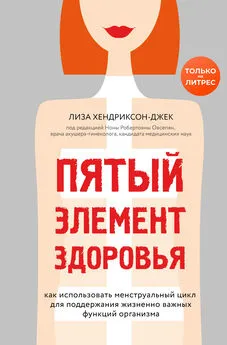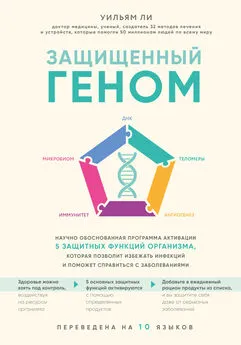Лиза Хендриксон-Джек - Пятый элемент здоровья. Как использовать менструальный цикл для поддержания жизненно важных функций организма
- Название:Пятый элемент здоровья. Как использовать менструальный цикл для поддержания жизненно важных функций организма
- Автор:
- Жанр:
- Издательство:Литагент 5 редакция
- Год:2020
- Город:Москва
- ISBN:978-5-04-104425-1
- Рейтинг:
- Избранное:Добавить в избранное
-
Отзывы:
-
Ваша оценка:
Лиза Хендриксон-Джек - Пятый элемент здоровья. Как использовать менструальный цикл для поддержания жизненно важных функций организма краткое содержание
«Почти» – потому что у женщин есть пятый показатель здоровья, на который, к сожалению, все еще мало кто обращает внимание, – это менструальный цикл. Короткий или длинный, регулярный или непредсказуемый – цикл может быть очень разным, и каждый его параметр, каждое изменение служат индикатором той или иной проблемы в организме. Планируете вы беременность или нет, овуляция имеет значение для поддержания здоровья.
Автор этой книги расскажет, что именно влияет на состояние менструального цикла, и научит вас составлять его график для максимально точного и удобного отслеживания различных изменений и контроля здоровья.
Пятый элемент здоровья. Как использовать менструальный цикл для поддержания жизненно важных функций организма - читать онлайн бесплатно ознакомительный отрывок
Интервал:
Закладка:
17. Troesch, Barbara, Birgit Hoeft, Michael McBurney, Manfred Eggersdorfer, and Peter Weber. “Dietary surveys indicate vitamin intakes below recommendations are common in representative Western countries.” British Journal of Nutrition 108, no. 04 (2012): 692–698.
18. Weber, Daniela, and Tilman Grune. “The contribution of β-carotene to vitamin A supply of humans.” Molecular Nutrition & Food Research 56, no. 2 (2012): 251–258.
19. Clagett-Dame, Margaret, and Danielle Knutson. “Vitamin A in reproduction and development.” Nutrients 3, no. 4 (2011): 385–428.
20. Li, Hui, Krzysztof Palczewski, Wolfgang Baehr, and Margaret Clagett-Dame. “Vitamin A deficiency results in meiotic failure and accumulation of undifferentiated spermatogonia in prepubertal mouse testis.” Biology of Reproduction 84, no. 2 (2011): 336–341; Thompson, J.N., J. McC. Howell, and G.A.J. Pitt. “Vitamin A and reproduction in rats.” Proceedings of the Royal Society B 159, no. 976 (1964): 510–535; Lamb, Adrian J., Piyaratana Apiwatanaporn, and James A. Olson. “Induction of rapid, synchronous vitamin A deficiency in the rat.” The Journal of Nutrition 104, no. 9 (1974): 1140–1148.
21. Hogarth, Cathryn A., and Michael D. Griswold. “The key role of vitamin A in spermatogenesis.” The Journal of Clinical Investigation 120, no. 4 (2010): 956–962; Busada, Jonathan T., and Christopher B. Geyer. “The role of retinoic acid (RA) in spermatogonial differentiation.” Biology of Reproduction 94, no. 1 (2016): 1–10; Chung, S.S.W., and D.J. Wolgemuth. “Role of retinoid signaling in the regulation of spermatogenesis.” Cytogenetic and Genome Research 105, no. 2–4 (2004): 189–202.
22. Huang, H.F.S., and W.C. Hembree. “Spermatogenic response to vitamin A in vitamin A deficient rats.” Biology of Reproduction 21, no. 4 (1979): 891–904.
23. Там же.
24. Hogarth, Cathryn A., John K. Amory, and Michael D. Griswold. “Inhibiting vitamin A metabolism as an approach to male contraception.” Trends in Endocrinology & Metabolism 22, no. 4 (2011): 136–144.
25. Clagett-Dame, Margaret, and Danielle Knutson. “Vitamin A in reproduction and development.” Nutrients 3, no. 4 (2011): 385–428; Talavera, F., and B.P. Chew. “Comparative role of retinol, retinoic acid and β-carotene on progesterone secretion by pig corpus luteum in vitro.” Journal of Reproduction and Fertility 82, no. 2 (1988): 611–615.
26. Thompson, J.N., J. McC. Howell, and G.A.J. Pitt. “Vitamin A and reproduction in rats.” Proceedings of the Royal Society B 159, no. 976 (1964): 510–535.
27. Ganguly, J., G.S. Pope, S.Y. Thompson, Joyce Toothill, J.D. Edwards-Webb, and H.B. Waynforth. “Studies on metabolism of vitamin A. The effect of vitamin A status on the secretion rates of some steroids into the ovarian venous blood of pregnant rats.” Biochemical Journal 122, no. 2 (1971): 235–239; Jayaram, M., S. K. Murthy, and J. Ganguly. “Effect of vitamin A deprivation on the cholesterol side-chain cleavage enzyme activity of testes and ovaries of rats.” Biochemical Journal 136, no. 1 (1973): 221–223; Best, Monica W., Juanjuan Wu, Samuel A. Pauli, Maureen A. Kane, Keely Pierzchalski, Donna R. Session, Dori C. Woods, Weirong Shang, Robert N. Taylor, and Neil Sidell. “A role for retinoids in human oocyte fertilization: regulation of connexin 43 by retinoic acid in cumulus granulosa cells.” Molecular Human Reproduction 21, no. 6 (2015): 527–534.
28. Whaley, S.L., V.S. Hedgpeth, C.E. Farin, N.S. Martus, F.C. Jayes, and J.H. Britt. “Influence of vitamin A injection before mating on oocyte development, follicular hormones, and ovulation in gilts fed high-energy diets.” Journal of Animal Science 78, no. 6 (2000): 1598–1607; Ikeda, Shuntaro, Masayuki Kitagawa, Hiroshi Imai, and Masayasu Yamada. “The roles of vitamin A for cytoplasmic maturation of bovine oocytes.” Journal of Reproduction and Development 51, no. 1 (2005): 23–35; Trojačanec, Snježana, Stanko Boboš, and Marija Pajić. “Influence of β-carotene and vitamin A supplementation on the ovarian activity of dairy cows with chronic fertility impairment.” Veterinarski Arhiv 82, no. 6 (2012): 567–575.
29. Charlton, Robert W., and Thomas H. Bothwell. “Iron absorption.” Annual Review of Medicine 34, no. 1 (1983): 55–68; Layrisse, Miguel, J.D. Cook, C. Martinez, M. Roche, I.N. Kuhn, R.B. Walker, and C.A. Finch. “Food iron absorption: a comparison of vegetable and animal foods.” Blood 33, no. 3 (1969): 430–443.
30. Charlton, Robert W., and Thomas H. Bothwell. “Iron absorption.” Annual Review of Medicine 34, no. 1 (1983): 55–68.
31. Scaglione, Francesco, and Giscardo Panzavolta. “Folate, folic acid and 5-methyltetrahydrofolate are not the same thing.” Xenobiotica 44, no. 5 (2014): 480–488.
32. Там же.
33. McEwen, Bradley J. “Methylenetetrahydrofolate reductase (MTHFR): mythology or polymorphism (ology)?” Advances in Integrative Medicine 3, no. 3 (2016): 79–81; Liew, Siaw-Cheok, and Esha Das Gupta. “Methylenetetrahydrofolate reductase (MTHFR) C677T polymorphism: epidemiology, metabolism and the associated diseases.” European Journal of Medical Genetics 58, no. 1 (2015): 1–10.
34. Fallon Morell, Sally, and Thomas S. Cowan. (2015). The Nourishing Traditions Book of Baby & Child Care. Washington, DC: New Trends Publishing, Inc.
35. Metz, Alan L., Mary M. Walser, and William G. Olson. “The interaction of dietary vitamin A and vitamin D related to skeletal development in the turkey poult.” The Journal of Nutrition 115, no. 7 (1985): 929–935.
36. Warinner, Christina, Jessica Hendy, Camilla Speller, Enrico Cappellini, Roman Fischer, Christian Trachsel, Jette Arneborg et al. “Direct evidence of milk consumption from ancient human dental calculus.” Scientific Reports 4 (2014): 7104.
37. Jianqin, Sun, Xu Leiming, Xia Lu, Gregory W. Yelland, Jiayi Ni, and Andrew J. Clarke. “Effects of milk containing only A2 beta casein versus milk containing both A1 and A2 beta casein proteins on gastrointestinal physiology, symptoms of discomfort, and cognitive behavior of people with self-reported intolerance to traditional cows’ milk.” Nutrition Journal 15, no. 1 (2015): 35.
38. Pal, Sebely, Keith Woodford, Sonja Kukuljan, and Suleen Ho. “Milk intolerance, beta-casein and lactose.” Nutrients 7, no. 9 (2015): 7285–7297.
39. Woodford, Keith. (2009). Devil in the Milk: Illness, Health and the Politics of A1 and A2 Milk. Hartford, VT: Chelsea Green Publishing.
40. De Noni, Ivano. “Release of β-casomorphins 5 and 7 during simulated gastro-intestinal digestion of bovine β-casein variants and milk-based infant formulas.” Food Chemistry 110, no. 4 (2008): 897–903.
41. Woodford, Keith. (2009). Devil in the Milk: Illness, Health and the Politics of A1 and A2 Milk. Hartford, VT: Chelsea Green Publishing.
42. Jianqin, Sun, Xu Leiming, Xia Lu, Gregory W. Yelland, Jiayi Ni, and Andrew J. Clarke. “Effects of milk containing only A2 beta casein versus milk containing both A1 and A2 beta casein proteins on gastrointestinal physiology, symptoms of discomfort, and cognitive behavior of people with self-reported intolerance to traditional cows’ milk.” Nutrition Journal 15, no. 1 (2016): 35; Fiedorowicz, Ewa, Maciej Kaczmarski, Anna Cieślińska, Edyta Sienkiewicz-Szłapka, Beata Jarmołowska, Barbara Chwała, and Elżbieta Kostyra. “β-casomorphin-7 alters μ-opioid receptor and dipeptidyl peptidase IV genes expression in children with atopic dermatitis.” Peptides 62 (2014): 144–149; Kamiński, Stanisław, Anna Cieślińska, and Elżbieta Kostyra. “Polymorphism of bovine beta-casein and its potential effect on human health.” Journal of Applied Genetics 48, no. 3 (2007): 189–198; Cade, Robert, Malcolm Privette, Melvin Fregly, Neil Rowland, Zhongjie Sun, Virginia Zele, Herbert Wagemaker, and Charlotte Edelstein. “Autism and schizophrenia: intestinal disorders.” Nutritional Neuroscience 3, no. 1 (2000): 57–72; Tailford, Kristy A., Celia L. Berry, Anita C. Thomas, and Julie H. Campbell. “A casein variant in cow’s milk is atherogenic.” Atherosclerosis 170, no. 1 (2003): 13–19; Laugesen, Murray, and Robert Elliott. “Ischaemic heart disease, Type 1 diabetes, and cow milk A1 beta-casein.” The New Zealand Medical Journal (Online) 116, no. 1168 (2003).
43. Chavarro, J.E., J.W. Rich-Edwards, B. Rosner, and W.C. Willett. “A prospective study of dairy foods intake and anovulatory infertility.” Human Reproduction 22, no. 5 (2007): 1340–1347.
44. Ravisankar, Panchumarthy, A. Abhishekar Reddy, B. Nagalakshmi, O. Sai Koushik, B. Vijaya Kumar, and P. Sai Anvith. “The comprehensive review on fat soluble vitamins.” IOSR Journal of Pharmacy 5, no. 11 (2015): 12–28.
45. Elgersma, A., S. Tamminga, and G. Ellen. “Modifying milk composition through forage.” Animal Feed Science and Technology 131, no. 3 (2006): 207–225.
46. Dhiman, T.R., G.R. Anand, L.D. Satter, and M.W. Pariza. “Conjugated linoleic acid content of milk from cows fed different diets.” Journal of Dairy Science 10, no. 82 (1999): 2146–2156; Staszak, Ewa. “Conjugated linoleic acid (CLA) content of milk from cows fed different diets.” Folia Biologica 53, no. 4 (2005): 103–106.
47. Smit, Liesbeth A., Ana Baylin, and Hannia Campos. “Conjugated linoleic acid in adipose tissue and risk of myocardial infarction.” The American Journal of Clinical Nutrition 92, no. 1 (2010): 34–40; Bhattacharya, Arunabh, Jameela Banu, Mizanur Rahman, Jennifer Causey, and Gabriel Fernandes. “Biological effects of conjugated linoleic acids in health and disease.” The Journal of Nutritional Biochemistry 17, no. 12 (2006): 789–810; Gaullier, Jean-Michel, Johan Halse, Kjetil Høye, Knut Kristiansen, Hans Fagertun, Hogne Vik, and Ola Gudmundsen. “Conjugated linoleic acid supplementation for 1 y reduces body fat mass in healthy overweight humans.” The American Journal of Clinical Nutrition 79, no. 6 (2004): 1118–1125.
48. Nozière, P., P. Grolier, D. Durand, A. Ferlay, P. Pradel, and B. Martin. “Variations in carotenoids, fat-soluble micronutrients, and color in cows’ plasma and milk following changes in forage and feeding level.” Journal of Dairy Science 89, no. 7 (2006): 2634–2648.
49. Schutz, M.M., L.B. Hansen, G.R. Steuernagel, and A.L. Kuck. “Variation of milk, fat, protein, and somatic cells for dairy cattle.” Journal of Dairy Science 73, no. 2 (1990): 484–493.
50. Pereda, Julieta, V. Ferragut, J.M. Quevedo, B. Guamis, and A.J. Trujillo. “Effects of ultra-high pressure homogenization on microbial and physicochemical shelf life of milk.” Journal of Dairy Science 90, no. 3 (2007): 1081–093.
51. Wiking, Lars, and Jonatan A. Dickow. “Effect of homogenization temperature and pressure on lipoprotein lipase activity and free fatty acids accumulation in milk.” Food and Nutrition 4 (2013): 101–108.
52. Douglass II, William Campbell. (2007). The Raw Truth About Milk: How Science is Destroying Nature’s Nearly Perfect Food and Why Animal Protein and Animal Fat in Your Diet Can Save Your Life. Republic of Panama: Rhino Publishing, S.A.
53. Kanner, J. “Dietary advanced lipid oxidation endproducts are risk factors to human health.” Molecular Nutrition & Food Research 51, no. 9 (2007): 1094–1101; Staprans, Ilona, Xian-Mang Pan, Joseph H. Rapp, and Kenneth R. Feingold. “The role of dietary oxidized cholesterol and oxidized fatty acids in the development of atherosclerosis.” Molecular Nutrition & Food Research 49, no. 11 (2005): 1075–1082; Staprans, Ilona, Xian-Mang Pan, Joseph H. Rapp, and Kenneth R. Feingold. “Oxidized cholesterol in the diet accelerates the development of aortic atherosclerosis in cholesterol-fed rabbits.” Arteriosclerosis, Thrombosis, and Vascular Biology 18, no. 6 (1998): 977–983.
Читать дальшеИнтервал:
Закладка:









